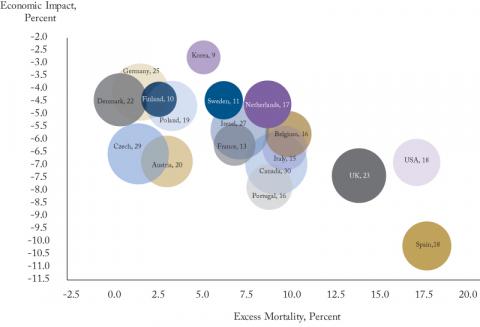From: William B.P. Robson
To: Canada’s Finance and Health Ministers
Date: January 18, 2021
Re: Addressing the Health Crisis is Addressing the Economic Crisis
The world has bid an unfond farewell to 2020 – but not, sadly, to COVID-19. A good time to review how the pandemic has affected health, livelihoods and public finances in Canada and abroad, looking for guidance towards better outcomes on all these fronts in the coming year.
Most people elsewhere responded to COVID by reducing potentially risky activities. Most governments imposed restrictions and used fiscal tools – notably transfers to households and businesses – to support incomes. Canada’s restrictions and fiscal supports have critics – of lockdowns for outsize collateral damage, for example, and for supports exceeding households’ and businesses’ COVID-related losses in some cases. How have other countries fared in mitigating the pandemic’s impact on health, economic activity, and public finances?
To make a comparison meaningful and manageable, I look at 17 other countries: members of the OECD with populations over 5 million for which we have comparable data on mortality and government debt (see figure).[1]
The foundation for the comparison is the severity of the disease. Because comorbidities complicate reporting causes of death, and other factors, such as COVID’s stress on healthcare, may also have affected mortality during the pandemic, excess mortality – total deaths in 2020 compared to prior years – is a widely used measure. Data compiled from the Human Mortality Database by Giattino et al. show weekly deaths in 2020 relative to averages for the same weeks from 2015 to 2019. The horizontal position of each country’s bubble in the figure represents its excess deaths up to the week of September 20, the latest date for which Canadian data are available. By this measure, Canada has done better than the UK, the US and Spain, but worse than many other middling performers, and much worse than several northern and central European countries and South Korea.
Turning to the economic impact, the OECD’s December 2020 Economic Outlook projects changes in real GDP and employment in 2020, which – like the mortality data – we can compare to changes in the previous five years. The vertical position of each country’s bubble reflects the average of these two indicators in 2020 compared to 2015-2019. By this measure, Canada’s experience has also been relatively bad.
Looking at excess mortality and economic losses together, a line drawn through the centre of each country’s bubble would slope down to the right, confirming the intuition that countries that mitigated the health impacts of the pandemic better suffered smaller losses of jobs and output.
The OECD also provides estimates of government debt relative to GDP for 2020, giving us a window into public finances. The size of each country’s bubble reflects the increase in its debt ratio relative to its 2015-2019 trend – a measure of changes in fiscal stance (this number also appears in the bubble). Looked at against the excess mortality and economic impact measures, the debt bubbles tell no compelling story. Tallies by the IMF show that countries spent relatively little in 2020 on healthcare measures directly related to COVID-19. Some income supports had positive health effects – increasing people’s ability to comply with lockdowns, for example. But a strict comparison of bubble size to excess mortality suggests no tendency for more debt to be associated with any outcome.
To repeat, while 2020 is over, the pandemic is not. Canadians, like citizens elsewhere, need faster and more comprehensive roll-out of vaccines. We also need more and faster testing, and better contact tracing. Our hospitals and long-term care facilities need more resources. Experience to date suggests that Canada has had unimpressive health outcomes, a relatively severe recession, and a significant fiscal response. To meet the continuing demands of the pandemic, Canada needs a more surgical approach to healthcare spending itself, to restrictions, and to cushioning the pandemic’s impact on our livelihoods. If international experience says anything, it says we should spend smarter.
William B.P. Robson is CEO of the C.D. Howe Institute.
To send a comment or leave feedback, email us at blog@cdhowe.org.
The views expressed here are those of the author. The C.D. Howe Institute does not take corporate positions on policy matters.
Figure: Excess Mortality, Economic Impact and Fiscal Responses by Country
Sources: Author’s calculations from data compiled by Giattino et al. and the OECD Economic Outlook database (December 2020).
Notes: Economic impact is average of changes in real GDP and employment. Debt ratios are changes relative to their 2015-2019 trend.
[1] Data on excess mortality are from the compilation by Giattino et al. from the Human Mortality Database. Data for Japan and Australia are not available in that compilation. Mortality figures for the UK are England and Wales only. I exclude Hungary and Slovenia because they reported negative excess mortality over the period. Statistics Canada’s probability-based data on excess mortality in Canada yield an average weekly figure of 4.4 percent over this period, but comparable calculations are not available for other countries.






